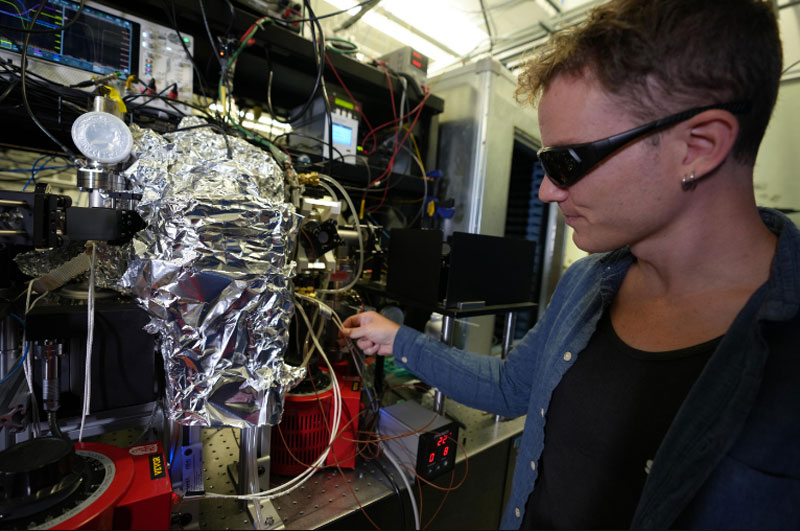Quantum physics helped to create an ultra -precise atomic thermometer


Scientists from the National Institute for Standards and Technologies (NIST) reported the creation of the most accurate and not requiring calibration of the atomic thermometer, which can find use in science, space and production. The work of the device is built on the principles of quantum physics and therefore impeccable. Modern scientific thermometers require long -term calibration and even in this case do not guarantee accurate measurements, from which the atomic thermometer is free.


Image source: NIST
The solution of researchers from NIST is based on the so -called Reidberg atoms. These are often made by Rubidia atoms. To do this, it is necessary to pump out the extreme electron so much that it increases the distance from the nucleus by three orders of magnitude. To understand the scale, imagine that the nucleus of an atom of 1 mm dimensions. Then the size of the “inflated” atom would be 30 m. When the atom becomes Reidberg, the size of the atom would increase to 1000 times, which in our example would correspond to 30 km. The electron at such a distance from the nucleus (in this atom) is sensitive to the external manifestations of magnetic fields and energies. And since everything is tied to quantum physics (properties of elementary particles), all these states and energy are calculated with an accuracy of 12 signs after a decimal.
Thus, measurements with the involvement of Reidberg atoms will be incredibly accurate even by default, simply relying on the fundamental properties of the universe (with the involvement of the necessary equipment and computing algorithms). However, this simplicity, of course, seems to be. However, equipment for organizing such a thermometer has become quite compact and may well be used in production.
In the atomic thermometer, Rubidia atoms are cooled to a temperature close to absolute zero (up to 0.5 mk). This reduces its own fluctuations in atoms (their energy) to the minimum level. The cloud of Rubidia atoms is held in space with an electromagnetic field, preventing it from contacting the walls of the camera. After that, the cloud is irradiated with lasers, and the farthest electrons absorb energy, after which they switch to orbit with 1000-fold exceeding standard orbits.
After that, it remains to monitor the behavior of remote electrons that absorb or give energy from the surrounding space. This energy is equivalent to the temperature of the measured object and is transferred to the photons emitted by it. When receiving and giving energy, the electrons change orbits and according to these changes, you can calculate the temperature of the object with extreme accuracy. Measurements are made in a contactless way, which in many cases is very convenient.
This breakthrough not only opens the way for the new class of thermometers, but is also especially important for atomic hours, since their accuracy can suffer from random heating. “Atomic hours are extremely sensitive to temperature changes, which can lead to small errors in their measurements,” the scientists explained. “We hope that this new technology will help to make our atomic clock even more accurate.”
All this will lead to new opportunities in science, in quantum calculations, improve autonomous navigation in long -range space (first of all) and will come in handy in many other areas.
Recent Posts
SnowRunner creators’ ‘revolutionary’ RoadCraft simulator earns ‘mixed’ reviews on Steam release
As promised, the “revolutionary” construction simulator RoadCraft from Saber Interactive (SnowRunner, Expeditions: A MudRunner Game)…
Google has taught Meet to translate speech on the fly while preserving intonation and tone of voice
Google unveiled a new live translation feature for its Google Meet video conferencing service at…
CMF Phone 2 Pro Review: Still Surprising
Last year, Nothing introduced the first smartphone under its budget sub-brand CMF by Nothing. The…
Google Chrome Will Start Automatically Changing Weak or Hacked Passwords, But Will Ask for Permission First
At Google I/O, the company announced a new feature in Chrome that will automatically update…
The End of Silent AI Video: Google Unveils Veo 3, the First Video Generator with Sound
Google presented the latest AI model for generating videos from text descriptions, Veo 3, at…
GTX 750 Ti is no longer enough for the game: Ubisoft announced the system requirements of Rainbow Six Siege X
Publisher and developer Ubisoft has revealed the system requirements for Tom Clancy's Rainbow Six Siege…